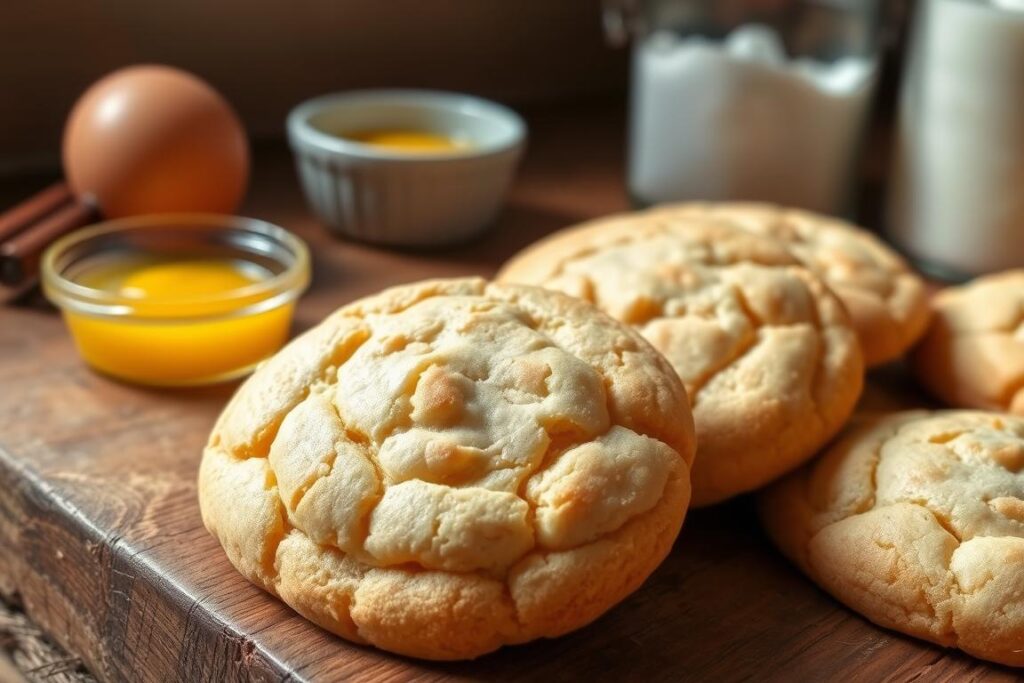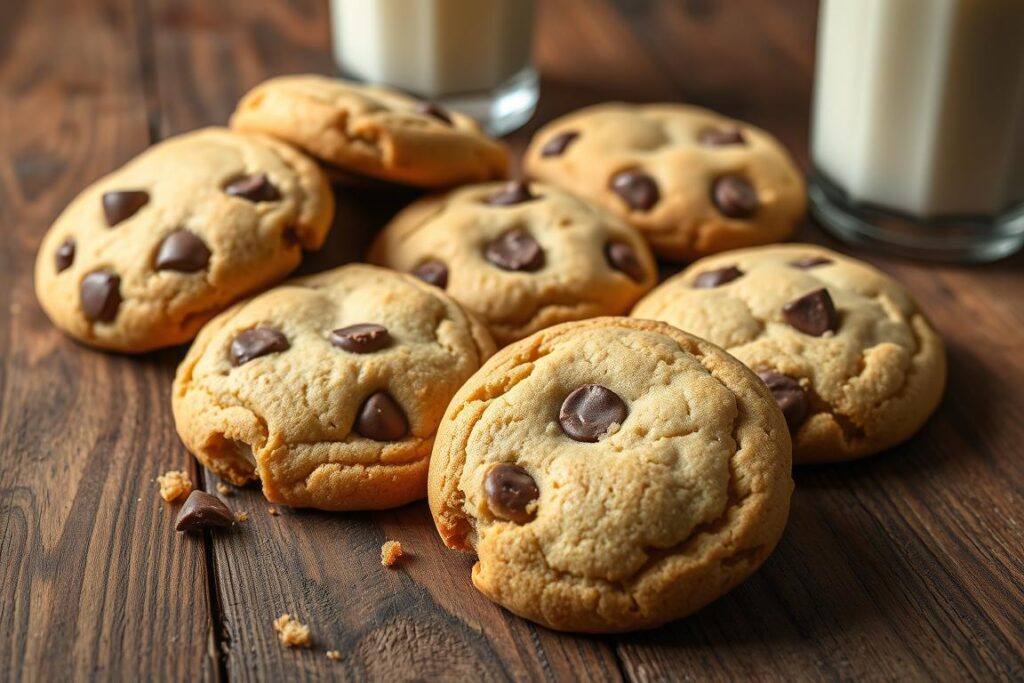Ever wondered why bakery cookies are so soft and chewy? It’s not just luck. It’s about the right ingredients and baking methods. Sugar types, fats, and flours all matter for that perfect cookie texture.
This article will dive into the science of baking soft cookies. We’ll uncover the secrets that make a simple cookie taste like one from a bakery.
Key Takeaways
- Understanding the key ingredients that contribute to soft cookie texture.
- The role of brown sugar and shortening in achieving optimal softness.
- Importance of baking techniques and ingredient temperatures.
- Methods for keeping cookies soft after baking.
- Tips for reviving stale cookies for a fresh taste.
The Science of Cookie Texture
The secret to perfect cookies is in the science of baking. Knowing how moisture and sugar types mix can make cookies melt in your mouth. Each part adds something special, keeping cookies soft and tasty.
Understanding Moisture Content in Cookies
Moisture content is key to cookie texture. The right amount of moisture makes cookies tender and chewy. Too little, and they’re dry and crumbly. Too much, and they’re soggy. Finding the right balance is crucial.
Role of Sugar Types in Cookie Softness
Sugar types change cookie softness. Brown sugar, with more moisture than white sugar, makes chewy cookies. White sugar, on the other hand, adds crispiness. Mixing different sugars lets bakers control cookie softness.
Exploring pasta, like tortellini, can add excitement to cooking. Learn more about tortellini and its fillings in this informative resource.
Key Ingredients for Soft Cookies
Soft cookies depend on a few key ingredients. Each one is important for that soft, delicious texture we all love. Knowing these ingredients helps make the perfect cookie.
Why Brown Sugar is a Must
Brown sugar is crucial for soft cookies. It keeps them moist because of its molasses. This makes the cookies taste richer and stay soft longer.
Its ability to hold onto moisture makes the cookies chewy. This is why brown sugar is a must-have.
The Importance of Shortening vs. Butter
Choosing between shortening and butter affects cookie texture. Shortening keeps cookies from spreading too much. This makes them thicker and sturdier.
Butter, on the other hand, can make cookies flatter. It has a lower melting point. The right choice can make a big difference in softness.
Using Cake Flour for a Soft Result
Using cake flour instead of all-purpose flour makes cookies softer. Cake flour has less protein, leading to a lighter texture. It also reduces gluten, making the cookies tender.
What makes bakery cookies so soft?
To make cookies soft like those from the bakery, egg yolks and cornstarch are key. These ingredients combine to create a texture that cookie lovers can’t resist.
How Egg Yolks Enhance Softness
Egg yolks add moisture and richness to soft cookies. They have proteins that make the cookies tender and less likely to spread too much. This keeps the cookies soft and chewy.
Using egg yolks instead of whole eggs helps keep the cookies soft and tasty. It’s a secret to making them extra special.
The Effect of Cornstarch on Texture
Cornstarch is often overlooked but it’s crucial for soft cookies. It softens the proteins in flour, making the cookies chewy. Cornstarch also absorbs moisture, making the cookies feel better in your mouth.
This ingredient helps the cookies keep their shape while baking. It’s how bakers achieve the perfect softness and structure in each cookie.

Baking Techniques for Soft Cookies
Getting soft cookies right means mastering certain baking techniques. Knowing the difference between baking powder and baking soda is key. Each plays a unique role in getting the right texture.
The Impact of Baking Powder vs. Baking Soda
Baking powder makes cookies airy and soft, like a cake. It’s because of its mix of acids and bases. On the other hand, baking soda makes cookies spread out, leading to a thinner, crisper cookie. The right choice can change everything.
Why Resting Dough is Crucial
Letting dough rest is a must for soft cookies. It helps keep moisture in, making the cookies chewier. This step also boosts flavor and texture.
Monitoring Baking Time for Best Results
Getting the baking time just right is crucial. A little underbaking can make the center soft and the edges set. Watching the cookies closely prevents them from getting too hard.
Temperature and Its Importance in Baking
Temperature plays a big role in how good baked goods taste. Knowing the difference between room temperature ingredients and cold ones is key. Ingredients like butter at room temperature mix better, making cookies light and fluffy.
Cold butter, on the other hand, makes cookies denser. This is good for pie crusts, helping them stay flaky.
Room Temperature Ingredients vs. Cold Ingredients
Choosing between room temperature ingredients and cold ones matters a lot. For cookies, the right texture comes from using room temperature ingredients. They help mix better, making cookies soft and moist.
Butter at room temperature holds air well. This makes cookies lighter and better at keeping moisture.
Effect of Oven Temperature on Cookie Softness
The oven temperature is also very important. If it’s off, your cookies can turn out wrong. Baking too hot can make them spread too much and get too crispy.
But baking at a cooler temperature helps cookies bake evenly. They stay soft and moist. So, keeping an eye on the temperature in baking is key to making soft cookies.
Secrets from Professional Bakeries
Professional bakers use special techniques and ingredients to make soft, tasty cookies. These secrets can make your baking better. By using these tips, you can get the perfect texture and flavor in your cookies.
Insider Tips for Baking Like a Pro
To make your cookies perfect, try these methods:
- Chill the dough before baking. This stops it from spreading too much and makes the cookies thicker.
- Use a mix of butter and margarine. This mix gives a rich taste and a soft crumb.
- Add sour cream or Greek yogurt to keep the cookies moist.
- Use cake flour instead of all-purpose flour for a softer cookie.
Common Bakery Substitutions for Soft Cookies
Not all ingredients are the same. Substitutions can change the texture and taste:
| Ingredient | Substitution | Effect on Texture |
|---|---|---|
| Butter | Margarine or Shortening | Can create a softer and chewier cookie |
| All-Purpose Flour | Cake Flour | Yields a lighter, more tender cookie |
| Granulated Sugar | Brown Sugar | Enhances moisture and softness |
| Eggs | Extra Yolk | Increases richness and moisture |
How to Keep Cookies Soft After Baking
Keeping cookies soft after baking is all about the right storage and ways to revive stale ones. By following these storage tips, you can keep your cookies moist and flavorful for a long time.
Storage Tips to Maintain Freshness
Using airtight containers is key to soft cookies. They block air and keep moisture in. A clever trick is to add a slice of bread to the container with the cookies. The bread soaks up extra moisture, creating a humid space that keeps cookies soft.
Methods to Revive Stale Cookies
To revive stale cookies, wrap them in damp paper towels and microwave them for a bit. This method adds back moisture, making the cookies soft again. These steps help ensure cookies stay delicious for everyone.
For more tips on keeping cookies soft, there are many other strategies to try.
Experimenting with Different Flavors
Trying out new flavors can turn soft cookies into amazing treats. Mixing different tastes can make them even better. It keeps them soft, which is what cookie fans love.
Flavor Combinations that Complement Soft Cookies
Here are some exciting flavor mixes:
- Chocolate and Peanut Butter: This pair adds a deep, rich taste.
- Lemon Zest and Vanilla: It’s a fresh mix that wakes up your taste buds.
- Coconut and Lime: Great for a tropical flavor.
- Mango and Ginger: A sweet and spicy mix that’s interesting.
These mixes add sweetness and keep the cookies soft and moist.
Customizing Recipes for Personal Preferences
Customizing recipes lets bakers make treats that are just right for them. Adding spices, extracts, or mix-ins can make cookies unique. It’s important to keep them moist to get the perfect texture.
Popular Soft Cookie Recipes
Soft cookie recipes win the hearts of cookie fans everywhere. The classic chocolate chip cookie is a timeless favorite. It’s loved for its mix of textures and rich tastes. Bakers can choose the traditional way or try new twists to delight their taste buds.
Classic Chocolate Chip Cookie Recipe
This recipe is a staple, made with butter, sugars, eggs, flour, baking soda, and chocolate chips. Using brown sugar helps make the cookies soft and chewy. They have perfectly baked edges too.
Unique Variations to Try
For a change, try unique variations. Add:
- Toffee bits for extra sweetness
- Flavored chips like mint or white chocolate
- Sea salt sprinklings for a contrasting taste
These additions can make a basic cookie recipe special. Bakers looking for softer cookies will love these creative ideas.

Conclusion
Understanding what makes bakery cookies soft is a mix of science and art. It’s about the right mix of moisture and the choice of ingredients like brown sugar. These secrets can make any cookie special.
By learning about egg yolks, baking temperatures, and resting dough, bakers improve their skills. This knowledge brings joy and a sense of achievement. It lets anyone make soft cookies that everyone loves.
The path to becoming a great cookie baker is fulfilling. By trying new flavors and techniques, bakers can make their cookies truly unique. Each batch becomes a special treat, full of sweetness and joy.


